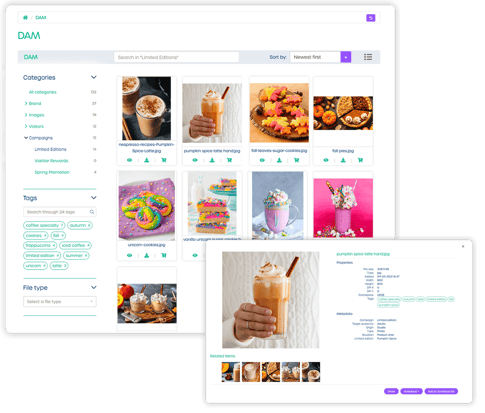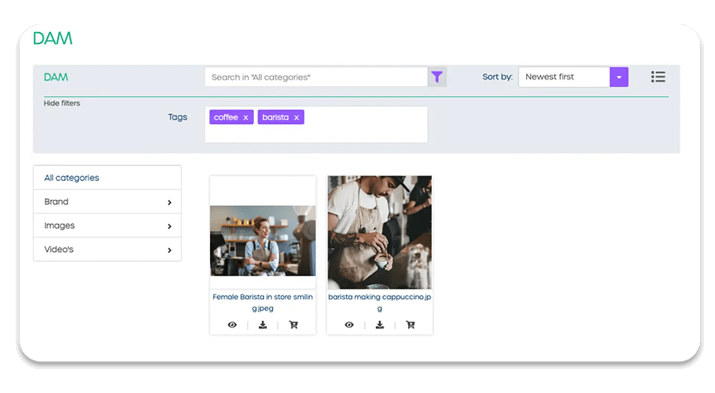What are Digital Assets?
Last updated: October 3, 2025
When you think of your favorite fast-food restaurant, what comes to mind first?
You most likely think of their to-die-for burgers and crispy fries. But, you'll also have flashes of their business color schemes, online recipe images, promo videos, and the logo. The images, logos, and videos are all digital assets.
Quick Definition of Digital Assets
A digital asset is any electronic content (or file) stored (digitally) and is uniquely identifiable, searchable, and comes with the right to use.
Digital assets can include images, videos, documents, presentations, etc. For any material to be classified as a digital asset, it needs to meet three critical criteria:
- Be a digital file owed by a company
- Provide value to a company
- Be identifiable, searchable, and discoverable
Nailing down the definition of digital assets is pretty challenging. For one, digital assets are continually evolving, with new digital formats cropping up. Also, value can be subjective from organization to organization.
However, the main issue is understanding that digital assets transcend various file formats. Digital assets can be any content in any file format, as long as it is stored digitally and has tangible value to an organization.
Digital assets are digital because they are a collection of binary data. The binary data format means the file is identifiable and can be understood and rendered by a computer, making it digital. The material being an asset means it has a perceived value for a company (financial and non-financial value).
.webp?width=409&name=assets-dam%20(1).webp)
Types of Digital Assets
Digital assets come in many formats. Here are seven examples of digital assets you're likely to encounter.
Images
Images are the most common digital assets. Why are they valuable? Brands can use images to portray their products in campaigns, promotions, and during the sales process. In addition, images are also a way for companies to build their brand identity. Think of company HQ images, photos of a company's team, and company events.

Videos
Videos are valuable to companies since they help a brand show how their products work and give customers a peek behind their team and culture.
Audio files
Podcasts are the most popular audio digital assets. Your organization can use podcasts to educate customers about your brand or build awareness through podcast content.
Presentations
Presentations come in the form of Powerpoint slide decks and one-pager documents. Presentations are powerful sales enablement assets for sales teams and business leaders since they help show your brand's USP.
Graphics
Graphics will consist of logos, vectors, and other custom art. Their primary purpose is to showcase the brand identity and create brand awareness.
PDFs
Brands prefer PDFs because they allow sharing and distribution of documents without formatting issues. You'll find brands using PDFs to share downloadable guides, reports, and whitepapers.
Spreadsheets
Spreadsheets come in the form of .xls and.csv files. Many brands view spreadsheets as digital assets since they allow the categorization, arrangement, and presentation of crucial data.
Why Digital Assets are Important
Digital assets may have several benefits up their sleeves, but their central importance is communicating and building connections with customers and prospects.
Below are two other reasons why digital assets are essential for any brand.
1. Digital Assets Help You Persuade Customers
Digital assets are the biggest way organizations influence customers to purchase from them.
Think back to your last marketing campaign. You definitely had product images, be it screenshots or original photos of your products. You might have also used videos, HTML documents for the landing pages, and sales decks for the hot leads.
Together these digital assets helped paint a picture of what your company offers to customers. The videos helped prospects understand the features and benefits. On the other hand, the HTML landing page expounds your product in detail, including the price, uses, features and benefits. And the sales presentation deck showed prospects your unique value proposition.
It would be challenging and next to impossible to persuade customers why your product is the best without digital assets.
2. Digital Assets Enable You to Build Your Brand Identity
Digital assets are also a way to build your brand identity. For instance, your brand logo is a unique identifier of your business. So, whenever customers see your logo, they are reminded of your brand. Ultimately the exposure of digital assets to customers increases brand awareness for your company.
The extent to which a digital asset is viewed as valuable will depend on:
How long it takes to create an asset— The longer an asset takes to create, the more a brand values it. For instance, videos for a specific local campaign might have more value than a simple stock photo. After all, you can simply renew your license to get a new stock photo. On the other hand, creating a new video will require time and several resources.
That said, how long it takes to create an asset is not the ultimate way to decide how valuable it is. A sales deck might take less time to build yet have more financial value than a product walkthrough video. You need to look at creation time together with what an asset helps you accomplish to find its actual value.
Reproducibility— Can you recreate the digital asset? If not, then an organization will place more value on assets that are not easily reproducible. For instance, a video of a one-off monumental event might have more value than a quick product walkthrough video that you can recreate.
Interoperability— If an asset can work in conjunction with other assets, then it has more value since it increases usage opportunities, saving on asset creation time and resources.
Digital Asset Management
If you don't have a digital asset management system to store and manage your assets, then sharing, distribution, and control will not be easy. In fact, in one study, 48% of the respondents said most of their digital assets end up unused because it's hard to locate them.
You might opt for a file folder, but that would result in a nightmare during campaign creation and everyday marketing. Your marketing and sales team will be forced to search through an outdated and largely ineffective folder (or folders) to find what they need. Case in point: Knowledge workers can spend up to 2.5 hours searching for information. That's 30% of their workday going down the drain!
In turn, your team wastes precious time, and campaigns take longer to go live.
Digital Asset Management (DAM) can help you solve this challenge.
Typically, DAM helps you in:
- Creating digital assets
- Storing and managing digital assets
- Sharing and distributing assets to various platforms and partners
- Securing your digital assets with permission controls
- Getting approval and reviews of digital assets from managers and other users
A DAM tool is like a library that houses all your assets under one roof (platform) for easy access and distribution.
With DAM, you can get campaigns out faster and with less frustration. DAM makes collaboration easier since you can share and distribute all your assets from a single portal. Also, establishing who has access to which assets is also simpler with DAM.
Since a great DAM platform comes with sophisticated technology and metadata to enhance the categorization and searchability of your assets, you remove the risk of repetition and unused digital assets.
Most importantly, DAM helps you maintain brand consistency by stipulating which type of digital assets are acceptable for campaigns and marketing.

Need Help with Your Digital Assets? Here's a Smarter Way to Manage Digital Assets
No organization is truly complete without digital assets. These assets allow customers and prospects to discover your products and services. Simply put, digital assets are critical in helping you influence your prospects' buying decisions. Also, digital assets will come in handy when you are building your brand identity.
But to get the most out of all your digital assets, you will require a DAM system that gets the work done.
We solved this issue by creating a cloud DAM platform that gives your organization the flexibility to manage, store and distribute your assets. Marvia helps you achieve these three goals in five ways:
Organize
Our DAM lets you categorize your digital assets into collections based on projects, types(documents, images, videos, etc.), and markets or partners.
Share
Let your team members, partners, and local branches (for national brands) access various digital assets. Sharing is made possible with a transfer link, curation of custom collections, or distribution into specific channels.
Preview
Marvia's DAM also lets you preview your assets, making it easier to choose the best-fit digital assets for a particular campaign, market segment, or product. What exactly can you preview? Everything. Get a glimpse of your videos, images, presentation, documents, and other content forms.
Protect your Assets
Easily add watermarks to your digital images, expiration dates, and publication rights. Also, establish who can edit, download and share specific digital asset groups.
Smart Search
Enable everyone to find digital assets quickly, thanks to meta titles, keywords, metatags, and other pertinent metadata options.
Overall, with Marvia's DAM, your team can reduce the time to market for your campaigns, keep everyone productive, and save resources.
Want to learn how to effectively manage your digital assets? Schedule a demo with Marvia and discover the best practices for organizing and leveraging your valuable digital resources.
